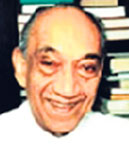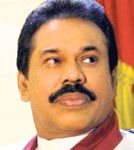In a week's time, celebrations begin prior to President Mahinda Rajapaksa
assuming office in his second term as Executive President of Sri Lanka. Although he won the Presidential Election held in January this year, he did not assume office for the new term since he completes his six-year term as President only this month. He will start his new term on November 19, after taking oaths before the
Chief Justice.
The 1978 Constitution of the Democratic Socialist Republic of Sri Lanka created the executive presidency whereby the President is the Head of State, the Head of the Executive, the Head of the Government, and the Commander in Chief of the Armed Forces.
 |
 |
 |
 |
J. R. Jayewardene |
R. Premadasa |
D. B. Wijetunge
|
Chandrika Bandaranaike Kumaratunga |
This is the Second Republican Constitution, the first being the
1972 Constitution when the
country became a Republic and a non-executive President replaced the Governor-General. William Gopallawa who was the incumbent Governor-General was the first
non-executive President.
The Executive President is elected by the people and holds office for a period of six years. He has the right to attend, address and send
messages to Parliament at any time. The President is also entitled to all the privileges, immunities and powers of a Member of Parliament other than the right to vote, and shall not be liable for any breach of the privileges of Parliament or of its Members.
President J. R. Jayewardene who was Prime Minister at the time the 1978 Constitution came into effect, became the first Executive President. When he completed four years, he called for a Presidential Election in keeping with the
provision in the Constitution
whereby the incumbent President can call for an election after
completing four years in office.
President Jayewardene was returned at the election held on October 20, 1982 when the voters went to the polls for the first time to elect a President. The system of voting was a novel experience to the voters. They not only had to vote for the
candidate of their choice but had to
indicate their second and third preferences as well. In case there was no candidate who received an absolute majority, the second and third preferences would determine the winner.
The ballot paper was also different. Instead of the usual cross (X), the voter had to mark '1' in the space provided on the right hand side of the ballot paper opposite the name and symbol of the candidate of his choice. He could also mark '2' and '3' against the names of the candidates of his choice for the second and third
preferences.
 |
| Mahinda Rajapaksa |
Every ballot paper carried the list of
candidates in Sinhala, Tamil and English in the way each candidate had given his name in the nomination paper. The names were arranged
alphabetically in Sinhala in the order of their surnames or the 'ge' names as indicated by the
candidates.
The voters could cast their vote between 7 in the morning and 4 in the afternoon. Counting was done at 165 counting centres.
President Jayewardene won the election and went on to complete a second term having taken his oaths on February 4, 1983.
At the end of the six-year period, nominations were called and the election was held on December 19, 1988. Prime Minister Ranasinghe Premadasa won the election over Mrs. Sirimavo Bandaranaike and assumed office on January 2, 1989. He would have tried for a second term but before he could
complete his term, he was as sassinated by a suicide bomber on May 1, 1993.
Prime Minister D. B. Wijetunge
succeeded in the interim period as President.
When it was time to elect a new President, Wijetunge announced that he had no intention of contesting and his party, the United National Party (UNP) nominated Gamini Dissanayake who was also
assassinated at an election rally
just two weeks prior to the election
scheduled for November 9, 1994.
The winner at the election was Chandrika Bandaranaike Kumaratunga, leader of the People's Alliance. Her victory meant a change in the party holding power as President. She was re-elected in December 1999 and went on to
complete a second term just as
J. R. Jayewardene did.
Prime Minister Mahinda Rajapaksa, the United People's Freedom Alliance candidate won the Presidential Election held on November 17, 2004 beating the
UNP leader Ranil Wickremasinghe. |






